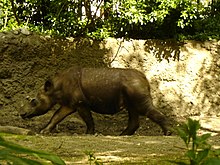Dicerorhinus
| Dicerorhinus Temporal range:
| |
|---|---|

| |
| Rapunzel, a Sumatran Rhino in the Bronx Zoo | |
| Scientific classification | |
| Domain: | Eukaryota |
| Kingdom: | Animalia |
| Phylum: | Chordata |
| Class: | Mammalia |
| Order: | Perissodactyla |
| Family: | Rhinocerotidae |
| Tribe: | Dicerorhinini |
| Genus: | Dicerorhinus Gloger, 1841 |
| Species | |
Dicerorhinus (Greek: "two" (dio), "horn" (keratos), "nose" (rhinos)[1]) is a genus of the family Rhinocerotidae, consisting of a single extant species, the two-horned Sumatran rhinoceros (D. sumatrensis), and several extinct species. The genus likely originated in the Mid to Late Pliocene of Northern Indochina and South China.[2] Many species previously placed in this genus probably belong elsewhere.[3]
Taxonomy[edit]
Species provisionally considered valid include:
- †Dicerorhinus fusuiensis[4][5] originally described as Rhinoceros fusuiensis[6] Early Pleistocene, South China.
- †Dicerorhinus gwebinensis Zin-Maung-Maung-Thein et al., 2008 Known from a skull of Pliocene-Early Pleistocene age found in Myanmar.[7] Some authors have considered the skull not distinguishable from that of D. sumatrensis.[8]
Historically, Dicerorhinus was a wastebasket taxon. Revisions by several authors over the years have removed many species:
Transferred to Stephanorhinus[3]
- Dicerorhinus merckii
- Dicerorhinus hemitoechus
- Dicerorhinus etruscus
- Dicerorhinus yunchuchenensis
- Dicerorhinus jeanvireti
- Dicerorhinus choukoutienensis (synonym of Merck's rhinoceros)
- Dicerorhinus orientalis (synonym of Merck's rhinoceros)
- Dicerorhinus nipponicus[9]
- Dicerorhinus megarhinus
- Dicerorhinus schleiermacheri
- Dicerorhinus ringstroemi
Transferred to Caementodon
- Dicerorhinus caucasicus[10]
Transferred to Lartetotherium
- Dicerorhinus sansaniensis
- Dicerorhinus cixianensis Chen and Wu, 1976[11]
Transferred to Rusingaceros
- Dicerorhinus leakeyi
Placement of the Sumatran rhinoceros among recent and subfossil rhinoceros species based on nuclear genomes (Liu, 2021)[12]
| |||||||||||||||||||||||||||||||||||||||||||
Bayesian morphological phylogeny (Pandolfi, 2023) Note: This excludes living African rhinoceros species.[13]
| |||||||||||||||||||||||||||||||||||||||||||||||||||||||||||||||||||||||||||||||||||||||||||||||||||||||||||||||||||||||||||||||||||||||||||||||||||||||
References[edit]
- ^ "Glossary. American Museum of Natural History". Archived from the original on 20 November 2021.
- ^ Mays, Herman L.; Hung, Chih-Ming; Shaner, Pei-Jen; Denvir, James; Justice, Megan; Yang, Shang-Fang; Roth, Terri L.; Oehler, David A.; Fan, Jun; Rekulapally, Swanthana; Primerano, Donald A. (January 2018). "Genomic Analysis of Demographic History and Ecological Niche Modeling in the Endangered Sumatran Rhinoceros Dicerorhinus sumatrensis". Current Biology. 28 (1): 70–76.e4. doi:10.1016/j.cub.2017.11.021. PMC 5894340. PMID 29249659.
- ^ a b c Tong, Hao-wen (2012). "Evolution of the non-Coelodonta dicerorhine lineage in China". Comptes Rendus Palevol. 11 (8): 555–562. Bibcode:2012CRPal..11..555T. doi:10.1016/j.crpv.2012.06.002.
- ^ Antoine, P.-O.; Reyes, M. C.; Amano, N.; Bautista, A. P.; Chang, C.-H.; Claude, J.; De Vos, J.; Ingicco, T. (2021). "A new rhinoceros clade from the Pleistocene of Asia sheds light on mammal dispersals to the Philippines". Zoological Journal of the Linnean Society. 194 (2): 416–430. doi:10.1093/zoolinnean/zlab009.
- ^ Pandolfi, Luca (2023-01-19). "Reassessing the phylogeny of Quaternary Eurasian Rhinocerotidae". Journal of Quaternary Science. 38 (3): 291–294. Bibcode:2023JQS....38..291P. doi:10.1002/jqs.3496. hdl:11563/163194. ISSN 0267-8179.
- ^ Yan, Yaling; Wang, Yuan; Jin, Changzhu; Mead, Jim I. (December 2014). "New remains of Rhinoceros (Rhinocerotidae, Perissodactyla, Mammalia) associated with Gigantopithecus blacki from the Early Pleistocene Yanliang Cave, Fusui, South China". Quaternary International. 354: 110–121. Bibcode:2014QuInt.354..110Y. doi:10.1016/j.quaint.2014.01.004.
- ^ Zin-Maung-Maung-Thein; Takai, Masanaru; Tsubamoto, Takehisa; Thaung-Htike; Egi, Naoko; Maung-Maung (November 2008). "A NEW SPECIES OF DICERORHINUS (RHINOCEROTIDAE) FROM THE PLIO-PLEISTOCENE OF MYANMAR". Palaeontology. 51 (6): 1419–1433. doi:10.1111/j.1475-4983.2008.00813.x.
- ^ Chen, Shaokun; Pang, Libo; Yan, Yaling; Wei, Guangbiao; Yue, Zongying (August 2021). "First Discovery of Dicerorhinus sumatrensis from Yanjinggou Provides Insights into the Pleistocene Rhinocerotidae of South China". Acta Geologica Sinica - English Edition. 95 (4): 1065–1072. doi:10.1111/1755-6724.14719. ISSN 1000-9515.
- ^ Handa, N.; Kohno, N.; Kudo, Y. (2019). "Reappraisal of a middle Pleistocene rhinocerotid (Mammalia, Perissodactyla) from the Matsugae Cave, Fukuoka Prefecture, southwestern Japan". Historical Biology. 33 (4): 218–229. doi:10.1080/08912963.2019.1604699. S2CID 145930245.
- ^ Antoine, P. O. (2003). "Middle Miocene elasmotheriine Rhinocerotidae from China and Mongolia: Taxonomic revision and phylogenetic relationships". Zoologica Scripta. 32 (2): 95–118. doi:10.1046/j.1463-6409.2003.00106.x. S2CID 86800130.
- ^ Deng, T.; Li, S., 2023. Restudy of Rhinocerotini fossils from the Miocene Jiulongkou fauna of China. Vertebrata PalAsiatica 61: 198-211 - DOI: 10.19615/j.cnki.2096-9899.230630
- ^ Liu, Shanlin; Westbury, Michael V.; Dussex, Nicolas; Mitchell, Kieren J.; Sinding, Mikkel-Holger S.; Heintzman, Peter D.; Duchêne, David A.; Kapp, Joshua D.; von Seth, Johanna; Heiniger, Holly; Sánchez-Barreiro, Fátima (August 2021). "Ancient and modern genomes unravel the evolutionary history of the rhinoceros family". Cell. 184 (19): 4874–4885.e16. doi:10.1016/j.cell.2021.07.032. hdl:10230/48693. ISSN 0092-8674. PMID 34433011. S2CID 237273079.
- ^ Pandolfi, Luca (2023-01-19). "Reassessing the phylogeny of Quaternary Eurasian Rhinocerotidae". Journal of Quaternary Science. 38 (3): 291–294. Bibcode:2023JQS....38..291P. doi:10.1002/jqs.3496. hdl:11563/163194. ISSN 0267-8179.
- Groves, Colin P., and Fred Kurt (1972). "Dicerorhinus sumatrensis". Mammalian Species (21): 1–6.
- "A new species of Dicerorhinus (Rhinocerotidae) from the Plio-Pleistocene of Myanmar" Archived 2020-10-11 at the Wayback Machine
